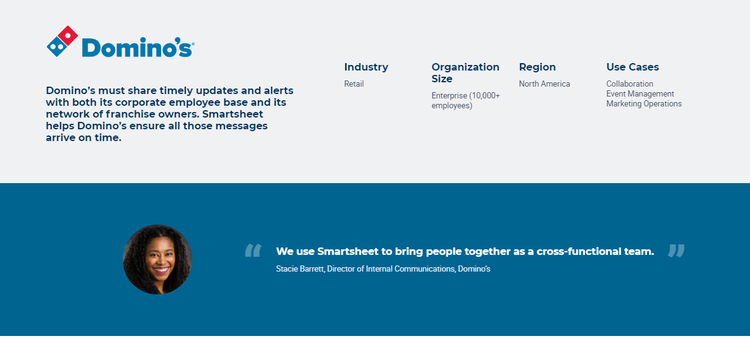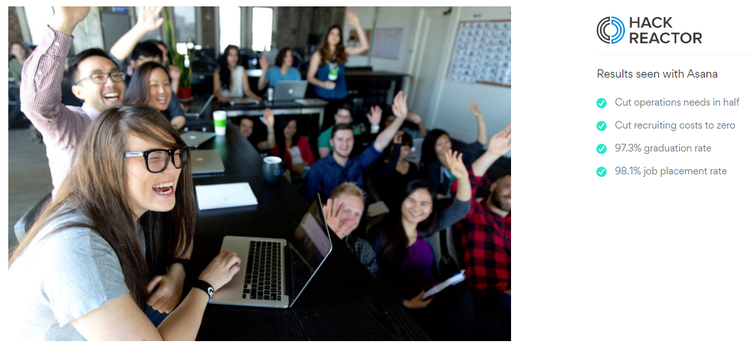Project managers must possess a whole list of things to be a success at project management:
- Practical tools such as project management software, visual cost and timeline charts, and a project tracker.
- Essential project management skills, such as leadership, negotiation, mentorship, networking, and asking the right questions.
- An understanding of commonly used project management terms, so everyone is on the same page throughout all project management phases.
A Project Management Institute paper authored by RMC Learning Solutions founder Rica Mulcahy found that great project managers “know that process is everything,” which, when used alongside essential leadership and soft skills, “gives the project manager the power to problems.”
Even if you do possess all of the above and recognize all of the project manager responsibilities expected of you throughout the different phases of a project, it doesn’t hurt to look at project management examples for guidance and direction.
Below, we’ll discuss three real-world examples of excellent project management for inspiration and the project management tips to take away from each.
1. Streamlining communications with Smartsheet
Domino’s is a widely recognized name in the pizza restaurant and delivery industry, operating 17,000+ stores in 90+ countries around the world. Worldwide, team members and franchisees total an estimated 350,000.
It’s no surprise, then, that communication, collaboration, event management, and marketing -- getting everyone on the same page, essentially -- used to be a challenge.
The objective
To provide employees and franchise owners with timely updates about new processes, new technologies, and changes to existing offerings. Awareness breeds efficiencies, after all.
The problem
The Domino’s internal communications team used multiple communication channels to disseminate key information, including newsletters, the occasional email for important updates, and the Worldwide Rally, an in-person event bringing together 9,000+ people every two years.
Worse, several people communicated to the same people using several different platforms. The result was recipients getting bombarded with the same messages repeatedly, causing them to overlook the important ones. As is generally the case with information overload, people were less informed instead of more.
According to Stacie Barrett, internal communications director at Domino’s, “Everyone thought their message was the most important message,” so they sent separate communication to make sure it got out.
The solution
Barrett knew her team needed to restructure the way it worked -- there was too much time and effort being expended for less-than-desirable results.
With Smartsheet, they now create a work plan spanning several months. The communications team enters standalone announcements and newsletter topics on a calendar.
Everyone has access to the same calendar, so team members can see how the schedule is looking, allowing for adjustments, if necessary, to prevent inundating recipients with updates and messages.
Thanks to a better project plan and a more efficient messaging workflow, from a measly 4%, the Domino’s newsletter read rate is now 100%.

Smartsheet allowed Domino’s to simplify its communications strategy and workflow, resulting in a newsletter read rate of 100% -- a significant jump considering that number used to be 4%. Image source: Author
Planning a project roadmap for the Worldwide Rally also happens within Smartsheet. If someone is out on vacation, someone else can step in without any problem because essential information -- such as the project plan outline, deadlines, and requirements -- is in the system for easy reference.
Automated alerts remind task owners of upcoming due dates and managers of overdue activities.
Takeaway
Project planning is usually a team activity -- as they say, two heads are better than one. Right from the start, all roles and responsibilities should be clearly defined, a project management best practice, to prevent confusion and duplication of duties.
Using a central workspace for all project-related updates and information that the internal communications team can access on demand, they’re better able to plan, delineate roles and task ownership, and roll out messaging campaigns that work for everyone’s benefit.
More on this story on Smartsheet’s website.
2. Scaling globally with Wrike
Airbnb Experiences is all about providing travelers with unique cultural experiences through multi-day trips hosted by experts from local communities. Among the many activities offered through the site are:
- A salsa dance party in Puerto Rico
- Stargazing and local wine tasting in Baja, Mexico
- An exploration of Cuba’s music scene with a celebrated DJ in Havana
- A hiking tour of the Atlas Mountains in Marrakech, Morocco
But even for a popular brand like Airbnb, scaling a new service after launch came with its own set of difficulties.
The objective
To quadruple the production of video trailers, photos, and other digital and print assets from the initial 12 cities to 50 worldwide.
The problem
At the time, creative production -- we’re talking about thousands of assets, here -- was managed using an online spreadsheet that couldn’t keep up with frequent changes, simultaneous users, detailed handoff requirements, and the massive content volume.
According to Hoon Kim, Airbnb’s creative production manager, “ was constantly crashing.” So, people duplicated the document “to deal with their own small world of data.” But because the duplicates weren’t connected to the master document, the result was confusion all around.
The solution
Kim and his team needed a tool that would streamline how they worked. They wanted a central work management platform that integrated with the other tools they already used, including Salesforce and Gmail.
They needed a tool that would allow team members to communicate and collaborate, wherever they were in the world, and they chose Wrike, which offers such project tracking capabilities.

To scale, Airbnb Experiences needed thousands of creative assets from creators in 50 cities worldwide. The team also needed a system to handle massive amounts of content, track updates in real time, and allow people to collaborate. Image source: Author
Takeaway
Effective communication is vital to project success, which is why about 90% of project management is spent communicating. Ensuring everyone’s working towards the same objective through a sound project communication plan allows services like Airbnb Experiences to scale seamlessly.
For more details on the Airbnb Experiences story, visit Wrike.
3. Standardizing processes with Asana
Hack Reactor is an education program that offers both in-person and remote software coding bootcamps. Hack Reactor locations in San Francisco, New York, Phoenix, Los Angeles, Austin, Seattle, Boulder, and Denver stage on-campus immersions.
As is often the case with companies operating in multiple geographies, ensuring service consistency across locations can be an uphill battle.
The objective
To standardize processes and ensure consistency of event types, feelings, and emotions across the different company locations at the same time.
The problem
In the early days, Hack Reactor CEO Tony Phillips had no problem keeping a lot of moving parts under control. But as the company expanded and the team became more and more fragmented, he wasn’t confident that all the details, including the small ones that made people feel “meticulous care has been applied to their education,” were being taken care of.
The solution
Asana has been instrumental in keeping things consistent for Hack Reactor. They made detailed process documentation available on the platform for easy universal access.
This way, teams know where to find the guidelines they need to perform their jobs well. Hack Reactor also makes extensive use of templates to “do exactly like this.”
As a result, they’re now more process-efficient, they’ve cut their operations in half, and Hack Reactor graduates are getting hired at a 98% rate.

Hack Reactor wanted its processes standardized. To do that, it made use of documentation and templates to keep things consistent across locations. Image source: Author
Takeaway
Staying organized is a project management nonnegotiable. You need to monitor and manage a whole slew of things: schedule, the project’s budget, team performance, deliverable requirements, resource availability, task updates, supplier and vendor reports, stakeholder expectations -- the list goes on.
Create task and process templates, or even a sample project plan for future reference, so you’re not always starting from scratch. Build systems for assigning repeatable tasks to the right people at the right time, just like Hack Reactor did, so “every detail is covered.”
Read more about Asana’s Hack Reactor case study here.
Take the learning up a notch with project management examples
We all can agree: Learning is a continuous process. And what better way to learn project management concepts than through actual, real-world examples? We hope you took away something of value -- perhaps a few new project management tips -- from the above.
Our Small Business Expert
We're firm believers in the Golden Rule, which is why editorial opinions are ours alone and have not been previously reviewed, approved, or endorsed by included advertisers. The Ascent does not cover all offers on the market. Editorial content from The Ascent is separate from The Motley Fool editorial content and is created by a different analyst team.